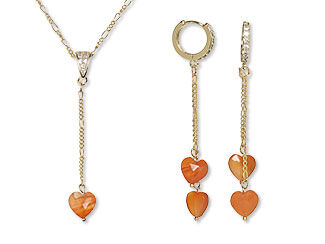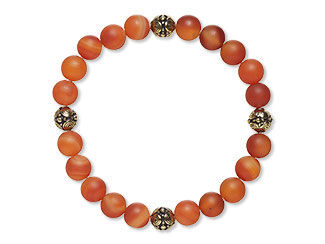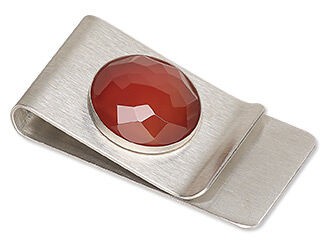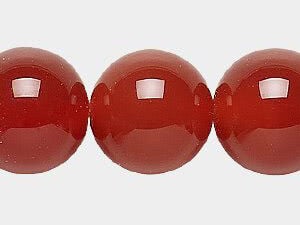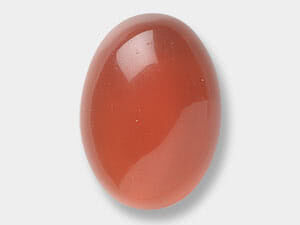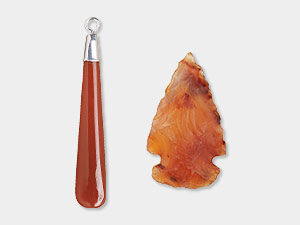Carnelian Meaning and Properties
Carnelian History
Carnelian is believed to be named after the red-orange Kornel cherry. Artifacts using carnelian date back to the Bronze Age circa 1800 BC on the island of Crete. Carnelian was believed by the Romans to be a stone of courage—able to shore up confidence and strength. In ancient Egypt, the stone was placed on mummies to assist the dead in their journey to the afterlife while architects to the pharaohs wore carnelian to denote rank and status. In the Middle Ages, carnelian was used by alchemists when boiling stone to release the energy of other gemstones.
Carnelian is the birthstone for the zodiac sign of Virgo (August 23 - September 22). For most cultures, from the 15th to the 20th century, carnelian was one of four birthstones for August. In 1912, the United States adopted peridot as the August birthstone, however in 2013, Britain recognized carnelian as a secondary birthstone after ruby.
Watch this video and learn more about the incredible history of this gemstone, its believed properties and how to incorporate it into your jewelry designs.

What are the Metaphysical Properties of Carnelian?
From antiquity, carnelian has been worn in cameos in the belief that it would ward off insanity and depression. In contemporary times, carnelian is thought by some to enhance self-esteem and creativity, to combat feelings of inadequacy, to increase physical energy and overcome insomnia. In the home, carnelian is believed to increase motivation towards action. It is sometimes used as a talisman to protect against fire and misfortune.
What Chakra is Carnelian?
Chakras are considered energy centers linked to various physical, emotional and spiritual facets of a person. Each chakra is believed to affect specific organs, moods and life experiences. Wearing chakra bracelets provides an easy and fashionable way to keep healing stones near you, helping to amplify their energetic effects throughout the day. Carnelian is considered to be part of the sacral chakra, which governs creativity, passion, emotional balance and the flow of energy related to pleasure and relationships. This chakra influences the ability to express emotions, embrace change and connect with others on an intimate level.
Sacral Chakra (Svadhishthana) - Orange
- Location: sacrum (location of the reproductive organs)
- Represents: emotions; openness; relationships; sexuality
- Emotional issues: intimacy; violence; basic emotional needs; pleasure; addiction
- Spiritual issues: enthusiasm; joy
- Physical issues: associated with the reproductive system, especially the uterus; urinary tract health
- Gemstones: carnelian, sunstone
What is Carnelian Made From?
Carnelian is a variety of chalcedony and is a microcrystalline quartz. As a chalcedony, carnelian is formed from the intergrowth of two silica minerals with differing crystal structures: quartz and moganite. Carnelian appears in a vibrant range of fire-orange reds to brown-reds and has a dull, waxy luster (as opposed to the vitreous quality of crystal quartzes such as amethyst). The reddish tints in the translucent stone are due to one of its ingredients: iron oxide. Carnelian can be confused with jasper, which is usually considered a chalcedony.
Carnelian is most commonly found in India, Brazil, Siberia and Germany.
Most carnelian gemstones are dyed and heat-treated to achieve additional color variations.
The method of dyeing will vary by the source, vendor and technology. Typically, carnelian gemstones, which are porous, are placed in vats of dye containing organic or vegetable dyes. Chemical salts and natural pigments may also be used. The stones may soak for several weeks to allow the dye to fully penetrate the stone and produce uniform surface color. Dyed carnelian has excellent stability, and some special care may be required.
Carnelian gemstones can also be heated to about 2900 degrees Fahrenheit, changing chemicals such as iron oxide, inclusions and impurities to produce different intensities or colors. Heated carnelian has excellent stability and can be cared for normally.
Certain carnelian gemstones may fade in light or heat. In fact, in India, these stones are treated with exposure to the sun, which turns the stone's brownish tints to purer reds.
- Mineral Information: Chalcedony, microcrystalline quartz group
- Chemical Composition: SiO2
- Color: Flesh-red to brown-red
- Hardness: 6-1/2 to 7 (Mohs)
- Specific Gravity: 2.58 – 2.64
- Refractive Index: 1.530 – 1.539
How Do You Clean Carnelian?
Clean carnelian stones with warm soapy water and a soft brush. Rinse the stone well after washing it. Do not steam clean and do not boil carnelian. It is usually safe to use an ultrasonic cleaner.
Protect carnelian from sharp blows, extreme temperature changes and harsh chemicals. Carnelian properties may include durability, but it’s not impervious to rough treatment.
Carnelian FAQ
Q: Is carnelian really chalcedony?
A: Carnelian is a form of chalcedony given its fiery hue by the presence of iron.
Q: Was carnelian used in an ancient language?
A: Carnelian was used by ancient peoples as amulets and talismans, often carved with words.
Q: Is Indian carnelian more valuable?
A: While Indian carnelian is revered for its depth of color, quality and long history, the carnelian properties of cut, color, clarity and size are more predictive of its value than its origin.
Q: Is carnelian rare?
A: While carnelian is not a rare gemstone, its rich, warm hues and smooth, polished appearance make it a highly attractive and popular choice. Its durability and affordability also contribute to its reputation as a reliable and beautiful stone for jewelry and decorative use.
Q: Can you bake carnelian in polymer clay or metal clay?
A: While carnelian is fairly durable, it is not recommended to bake the stones with your polymer clay or metal clay pieces. Bake your creation first, and then adhere the stone once the design is cool.
Designing with Carnelian
Rich tones of gold play off the warm color of carnelian, but it is more often seen in designs with silver, antique silver or with pewter. Combined with deeply contrasting black onyx, the fire-reds of carnelian become even more vibrant for a sophisticated casual look. For a more adventurous impression, combine it with green aventurine and a hint of something blue like lapis lazuli or sodalite. Or, to create an exciting treat for the eyes, combine the fire-orange stone with vivid blue-green turquoise.
A Few Design Inspirations to Get You Started
Aren't the warm, rich hues of fall just lovely? Join Patti in creating your own autumn-inspired carnelian earrings featuring carnelian gemstone chips and charming leaf accents. Perfect for both beginners and seasoned crafters, these stylish earrings are simple to make! Watch this video to learn how.

Shop for Carnelian
**Please note that all metaphysical or healing properties listed are collected from various sources. This information is offered as a service and not meant to treat medical conditions. Fire Mountain Gems and Beads® does not guarantee the validity of any of these statements.
How did you like this resource? Your feedback helps us provide resources that matter to you most.
Copyright Permissions
All works of authorship (articles, videos, tutorials and other creative works) are from the Fire Mountain Gems and Beads® Collection, and permission to copy is granted for non-commercial educational purposes only. All other reproduction requires written permission. For more information, please email copyrightpermission@firemtn.com.

